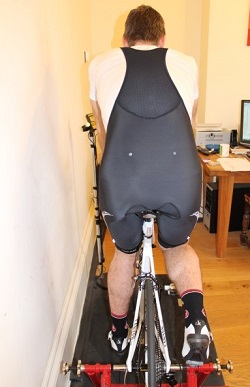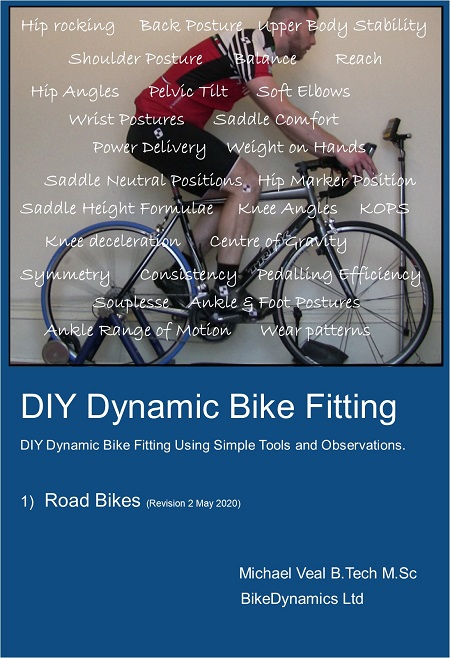Saddle Height

Saddle Height - Maximum Knee Angle
The ideal saddle height can be described by the angle of the knee at full extension. Typically, men will be close to 141° and women maybe 1-2° higher. The difference is due to flexibility, with looser female hamstrings allowing the knee to extend further. Tight hamstrings will inhibit the extension of the knee, so many people find that being less than 140° may suit them better. Please note that these are dynamic measurements, i.e. whilst pedaling and that static measurements may be different.

Saddle Height - Minimum Knee Angle
The problem with only using knee maximum extension to define saddle height is that the equally important minimum knee angle is neglected. Avoid an angle less than 70° as this can put high shear forces into the knee joint, exaggerate the 'dead zone' at the top of the pedal stroke and cause discomfort in the hip and lower back. If too tight, moving your cleats back will help, but you will most likely need shorter crank arms.

Ankle Postures
Knee angles are a good way to help define an appropriate saddle height, but good Bike Fitters will quickly realise that the human body does not behave in a nice linear fashion. For instance, one might assume that lowering the saddle height will reduce the knee angles, but counter-intuitively, this is not always the case. One of the explanations for this is concerned with what we do with our ankles. A very toe down ankle posture is an indicator of an excessively high saddle, as is a large range of articulation of the ankle joint (>20°). Similarly, low heels and a small range of ankle articulation (<15°) would support a theory that the saddle is too low.

Hip Rocking
Rocking of the hips is often used as an indicator that the saddle is too high and needs to come down a couple of mm. Unfortunately, this is an unreliable indicator as many people's hips will rock irrespective of the saddle height. This can be due to poor core strength, but we can't always blame the cyclist. A low saddle can also cause the pelvis to rotate in response to the rising knee, as will excessively long cranks.
Saddle Height Calculators
Often called the LeMond formula, the best known saddle height calculator is probably
Height(mm) = Inseam(mm) x 0.883.
Plotting this graph for a number of BikeDynamics customers gave a very similar correlation of:-
Height(mm) = (inseam(mm) x 0.8766) + 9.8.
I was pleased with this as it does agree quite closely with LeMond, but also predicts a typical shoe / cleat stack height. We may all have different leg lengths, but tend to use the same thickness shoes and pedal systems. The only concern was that the R2 value was only 0.91, which for those that know their stats is an 'ok' correlation but not good enough. See here for further details on Saddle Height Calculators.
What Actually Matters - Saddle Height Sweet Spot!
Most cyclists will have a saddle height 'sweet spot', and as a rule the optimum height for power will be the same as for efficiency and injury prevention. This sweet spot may be better defined as a window, often just 2-3mm wide with noticeable compromises if outside the range. Long legged people with relatively short crank lengths will have wide windows and barely notice a saddle height change of 5-10mm away from their nominal. Finding the sweet spot becomes more problematical for people with leg length discrepancies and relatively long crank arms. In many instances, the saddle can be both too high and too low at the same time! At BikeDynamics we use at least 10 separate pieces of information to help define a saddle height. These include the items above, plus anatomical measurements, height calcuators, injury history and subjective impressions.
DIY Dynamic Bike Fitting
You may be interested in our downloadable DIY guide.
49 Page PDF download describing all the observations, simple measurements and calculations required to do your own Dynamic Bike Fits.
Revision 2 released May 2020.
Contains updated male and female saddle height calculators and new information on male / female leg length proportions. Plus a new section to assist with saddle choice and improving comfort.
British Pound, Euro and US Dollar payments are processed by PayPal and all major credit cards are accepted. You will receive an email confirming your payment and will be automatically redirected to a page where you can download the ebook. The ebook is in PDF format so you will need to have a copy of Adobe Acrobat Reader or a similar PDF reader to read the ebook.


